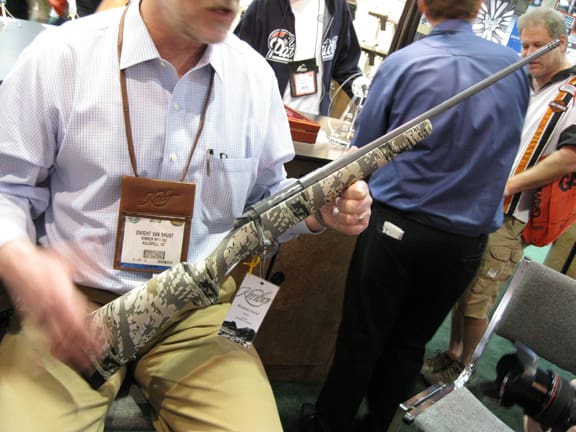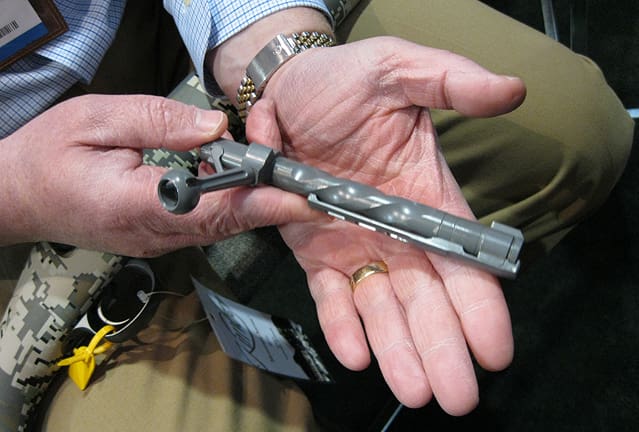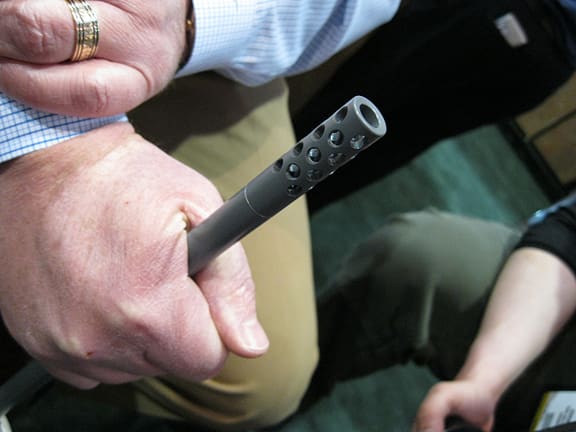Kimber. 1911s. Kimber. Mountain rifles? When you have a strong brand, offering your loyal customer base line extensions like this makes perfect sense. Financially. In the short term. In the long run you run the risk of becoming Porsche, a legendary sports car maker that now bases three-quarters of its business on pug-ugly trucks. Then again, Kimber actually started out making rifles. And Kimber’s new Mountain Ascent isn’t aesthetically challenging; it’s a traditional hunting piece. And here’s the kicker: the Mountain Ascent’s built from decidedly non-traditional materials, making this a gun light enough to carry all day long. . .
Thanks to Dan Hall at GunUp, TTAG got the nickel silver dollar tour of Kimber’s new products from Dwight Van Brunt. Van Brunt was blunt (although he wasn’t smoking one): it’s all about the weight, or lack thereof. The Kimber Mountain Ascent weighs a scant 4 lbs., 13 oz. Holding the gun, it feels like Van Brunt’s erring on the side of avoirdupois. Carrying this gun over hill and dale will be about as physically taxing as watching Chip and Dale.
Kimber’s trimmed every quarter ounce out of the Mountain Ascent’s heft. They’ve fashioned the stock from Kevlar-reinforced graphite. They’ve hollowed out the handle for the spiral fluted bolt. Thanks to the Kimpro II coating, the Kimber Mountain Ascent’s action is as smooth as Candice Swanepoel’s thighs. If it’s all too much (the rifle not the South African supermodel), you can remove that muzzle brake from the long gun’s 22” partially-fluted, tapered barrel.
In case you had trouble making out the gun in the photo at the top due to that high tech camo pattern . . . oops. Dwight was very specific: the pattern isn’t camo. Oxymoronically enough, it’s called ‘open carry concealment.’ In addition to the .308 caliber model, Kimber’s set to offer the Mountain Ascent in .270 Win, .30-06 and the esoteric .280 Ackley Improved.
Kimber says the Mountain Ascent will start climbing the sales chart in about three months. MSRP: a cool two grand. We’re hoping to get our hands on this non-1911 Kimber product for review before too long. Watch this space.







.280 AI is hardly “esoteric.” It’s been around since… well, since shortly after the .280 was introduced. With modern powders, you can get ballistic performance nearly the equal of 7mm RemMag.
Among those who handload, the .280 and .280 AI are a very popular all-round hunting cartridge. Better bullet selection than a .270, better ballistics (especially in such a light rifle) than a .30-06.
The .280 and .280 AI are very popular?!
Compared to what, an albino unicorn?
Actually, the .280 AI is the perfect hunting cartridge for albino unicorns.
If unicorns are already white, what color are albino unicorns?
Colorless and transparent. That’s what makes bagging one such an achievement.
I said “among those who handload.”
You folks who get all your information from glossy gun magazines… don’t worry about it. Just keep buying the latest and greatest magnum being hawked by the glossy magazines.
Also, .280 AI is actually the only Ackley-Improved cartridge that is a SAAMI standard and not a wildcat.You can even get Nosler brass for it if you don’t feel like fireforming (note that SAAMI .280 AI has slightly different headspace from “traditional” .280 AI thanks to Nosler). Also, my experience has been that Nosler brass is not worth the money. Sure, it’s consistent, well prepped, and ready to go, but it’s soft and doesn’t last very long or tolerate warm loads; you can form .280 AI brass from Lapua 30-06 and it will last you for a long time.
I have found in the three loadings I’ve used (.270 Win, .30-06 and .308) of Nosler brass that it is softer than other sources of brass. It loads very well, it shoots very well… but by the third or fourth reloading, I can no longer get the brass to hold the primer in the pocket. I’ll do a lot of fussing with brass, but pre-staking the pocket with a punch to get it to hold the primer is where I’m drawing the line…
I wouldn’t go so far as to say “most,” but I know many States set a caliber limit and disallow hunting with anything less than .30 for anything aside from small game (rabbits and squirrels and such).
I personally know of no such states.
Edit: I just found that Indiana appears to require rifles use pistol cartridges larger than .357, but it appears they don’t allow real center-fire rifle cartridges. I’ve never hunted in the midwest and this seems like a silly reg on it’s face, but there it is.
I do know that many western states set a minimum of .224 caliber centerfire, Nevada requires larger than a .224 centerfire for big game, Wyoming requires a minimum of .230 bore diameter and at least 2″ overall cartridge length, MN requires .220 bore diameter centerfire, etc. Some states set an additional requirement for species like elk (eg, KS requires .25 cal or larger, and sets a minimum OAL).
Some time back, I remember reading that the B&C database showed that more B&C trophy entries were taken with a .300 WM, followed by a .270 Win, followed by the venerable .30-06.
es·o·ter·ic/ˌesəˈterik/
Adjective:
Intended for or likely to be understood by only a small number of people with a specialized knowledge or interest.
…you can remove that muzzle break from the”
It’s done wrong so often that it’s passed into “accepted use” (a concept which I find abhorrent in general; see irregardless, alot, etc.), but the correct term is muzzle brake.
I know it’s pedantic, but this is a gun blog, after all.
Text amended.
Yeah, you wouldn’t want your muzzle to break, now would you? Just slow down a bit…
I understand the concept of making rifles lighter so you can carry them all day marketing, but lets get real about an issue not mentioned in this article, the lighter the rifle, the less recoil that is absorbed from a rifle round. So, unless you put this in a lead sled, it will be less pleasant, in theory, to shoot than say a heavier rifle.
A friend of mine once told me that anyone who complains about carrying the weight of their rifle up and down the mountain should look at their own waist-line first.
No 7mm/08, 257 or 243?
Seems like they would have been perfect calibers for this firearm.
The Savage Edge (now Axis) is a bolt action .308 that weighs (with scope) just over 6 pounds. It is the most unpleasant firearm I’ve ever fired. There is not a chance in hell I’d buy this in .308 nevermind .30-06. I wouldn’t mind one if I was varmint hunting and going to be in the field all day and wanted an uber lightweight .204/.223/.22 Hornet/.22-250/.25-06 or something. But a .30-06 with anything smaller than the Barrett .50 BMG muzzle brake, no thanks.
My 5 and 1/2 pound kimber 308 sporter in walnut is a joy to shoot. Last time I took it out I came home home with a 170# whitetail. Carrying that and an FN-45 16 round as a sidearm, as well as my usual kit, wasn’t bad. A couple of beers and a night cap back at camp had a larger toll on my 160 pound frame than the 6 hour hunt. That being said, the kimber 308 has a kick you notice, but nothing I’d call punishing. But then my first real hunting rifle was a model 94 30-30 when I was ten, and Dad gave me the 30-06 model 70 when I was 13. If I had the money to buy one of these new lightweights, I might. Not likely though.
Seems to me there is a lot better caliber selection (like, everything) at a significantly lower price point in their Montana rifle. (MSRP 1359 v. 2040 for this new rifle). Stainless instead of kimpro, and no brake, but only 5 ozs. more.
Comments are closed.